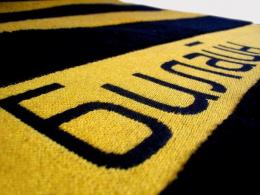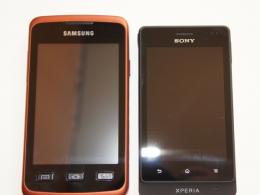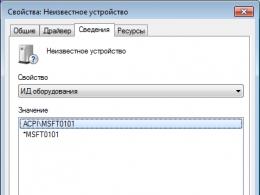Problem installing Adobe Flash Player updates. Installing and updating Adobe Flash Player
What to do if it's outdated Adobe plugin Flash Player? It's simple: it needs to be updated. Although, in principle, this is not necessary. But then you will not be able to listen to music on VKontakte, watch videos on Youtube and play games in the browser. And all because in this case special drivers are required. And all of them are available in Adobe Flash Player. Therefore, whatever one may say, you still have to update it.
But I have 3 good news. Firstly, this is done in literally 2-3 minutes. Secondly, it's completely free. Thirdly, below is detailed instructions, how to update Adobe Flash Player on a computer or laptop.
How to update Adobe Flash Player correctly?
First, let me explain one thing important point, which you definitely need to know. While working in the browser on any website, the message “Adobe Flash Player is out of date” (or “An outdated module / plugin of Adobe Flash Player is blocked”) periodically appears. In principle, the text may differ slightly, but the essence remains the same. What does Adobe Flash Player mean? It's simple: the developers have released a new version, and your current one is no longer relevant. Therefore it needs to be updated.
The following may also remind you of the need to update:
- antivirus;
- online player on some website;
- Flash Player itself (for example, in the tray).
Under no circumstances agree to this reminder and do not click the “Update” button! Just read the message and close it. The fact is that it may contain viruses. Especially if the message appears on an unknown site.
Adobe Flash Player must be updated only from one single source - the official website of the developer. IN otherwise you risk infecting your computer or laptop with all sorts of viruses (most often it is a ransomware banner that blocks the operation of the PC).
Is everything clear with this? Then let's move on to the main thing.
Below I will show an example for Windows 7 (in Firefox). However, this procedure is universal. That is, in the same way you can install Adobe Flash Player for Opera, Chrome, Internet Explorer, Yandex and all OS (Windows XP, 8 or 10).
So, to properly update an outdated Adobe Flash Player to the latest version:
- Go to the address – https://get.adobe.com/ru/flashplayer/ (this is the official website of the developers and you only need to update it here!).
- Pay attention to the first column. The OS version and browser are indicated here. If they are defined correctly, go to step 4.
- If the OS or browser is identified incorrectly, then click on the line “Do you need Flash Player for another computer?” After this you will be able to manually select Windows version and installed browser.

- The second column indicates additional applications, which will be installed along with Adobe Flash Player. Usually, few people need them, so it is recommended to uncheck the boxes here.

- In the third column, click on the “Install” button.

- After this, a small window will appear in the browser where you need to click the “Save file” button (save to any location - for example, to the desktop).

Hide the browser and run this file. The Adobe Flash Player installer will open, where you need to select update settings. There are 3 options to choose from:
- automatic update Adobe Flash Player;
- notify before installing updates;
- never check for updates.

After this, the installation of the latest version of the plugin will begin. In this case, you need to close the browser. If you do not do this, the following message will appear during installation:

Close the browser and click “Continue”.
After updating Adobe Flash Player, your browser will automatically start and open official page developers.
It will say something like “Thank you for using our product.” You don’t have to pay attention to this - just close this tab.

But there may be one problem. Updating the plugin to the latest version periodically fails. And as a result, videos, music and games still don't work. Or they work, but poorly: the video is slow, the browser is glitchy, sites freeze, etc. This happens sometimes. In this case, you need to roll back Adobe Flash Player to previous version and then install it again. That is, it is required complete reinstallation flash player.
How to remove Adobe Flash Player?
There are no difficulties here. To remove Adobe Flash Player:

Done – the plugin is completely removed from your computer (or laptop).
If you have already deleted the installation file on your desktop, then you need to download the Adobe Flash Player update again from the office. site and install it from scratch. Typically this should help. After this, games, videos and music will play normally.
Sometimes standard procedure removal does not help resolve audio or video errors in the browser. In this case, I recommend reading: ?
Beginners and experienced users PC and Internet are faced with the same problem: the video does not play in the browser and the message “ Adobe flash player is outdated" In this article we will give you useful tips on how to resolve this failure and restore the player's operation.
What to do if Adobe Flash Player is outdated?
Adobe flash player You can update it for free, but first determine the reason that caused it to malfunction. If your games do not work, videos do not play, and certain sites do not open, try uninstalling and reinstalling Flash Player. Another reason why the failure occurred is the plugin settings in the browser you are using.
I would like to note that some browsers already have a built-in Adobe flash player plugin, but if you accidentally install it again, a plugin conflict occurs and sites stop opening. This is why it is important to pay attention to browser features and plugin settings.
It is important to update the flash player in a timely manner, as updates may include new modules that increase security. You can even install special program, which will remind you of the availability of updates for individual programs. If you do not plan to install additional extensions, then just check what version of Flash Player is installed on your computer.
If you have any Google plugin conflict then enter chrome:plugins in the address bar
and enable the Flash Player plugin. Pay attention to how many plugins you have working together; if there are two, then you need to disable one. If you use Yandex, then enter browser://plugins into the search and carry out the same operations as in Google.
We hope that our article was useful and you will be able to adobe flash player update free, and also resolve the issue with plugin conflicts. The tips in this section will make using your PC convenient.
Rate this post
Install via offline installer
This method is suitable if you want to install Adobe Flash Player when there is no Internet access, or when Internet speed is low and unstable. To do this you need to first download full version installation files, and then you can, at a time convenient for you and in the absence of an Internet connection, make Flash installation Player. To download the offline installer, follow the link below and select your browser, and then “Download offline”.
We run the installation once
Do not run the downloaded plugin more than once, as the application will not install. After running once, wait. If you clicked several times, then launch the “Task Manager” and stop the corresponding processes. You can restart your computer and repeat the installation, running it once.
Disabling the antivirus
If an error occurs during the installation process, then try disabling the antivirus. This is due to the fact that some installer actions are blocked antivirus program. Once the installation is complete, launch it again.
Effect of virus software
This reason is in last place. Scan your system for viruses using the antivirus that is installed on your computer or using special utility Dr.Web CureIt. Eliminate detected viruses, then restart your computer.

If all else fails
If all the above tips did not help you, then try it, which has a built-in flash player. Another, more drastic way is to reinstall Windows on your computer.
Undoubtedly, everyone who works with the Internet, multimedia content, or is a developer of web or media applications constantly encounters an integrated plug-in based on Flash technology from Adobe Corporation. Let's consider the question of how to update Flash plugin Player in several simple ways in different browsers without affecting the development environment.
and what it is needed for: general information
Flash technology itself is unified. A player built into browsers based on it allows you to display the multimedia content of a web page most correctly and in full. These include vector and raster graphics, animation, video and audio.
The plugin itself is installed in the form of special libraries, and does not have an executable component to run as an EXE file, so use it in the form regular program impossible - only in the environments in which it is integrated. Question about how to update Shockwave plugin Player or Flash Player, we will consider in relation to Internet browsers, although some points should be taken into account by developers.
What is the difference between Adobe Flash Player and Adobe Shockwave Player?
Many users, apparently out of ignorance, believe that these two names correspond to the same plugin. This is fundamentally wrong. Although the technologies used in their functioning are very similar in their core, in fact there is quite a big difference between them.

Adobe Flash Player is the standard version with a minimum set of features. But Adobe Shockwave has much more of them. The toolkit includes XML parsing tools, HTML management, supports control of vector shapes and objects, allows remote file search, has a special scripting language, etc. It is not surprising that it is on its basis that most multi-user chats are created.
Let's see how to update the Shockwave Flash plugin or standard player. To make it easier to understand, let's combine them into one whole.
How to update plugins automatically
During the initial installation, the plugin embeds its own updater into the system, which is always in active mode by default. If you have a permanent Internet connection, there is no update problem.

The updater itself monitors the appearance of new versions and at a certain moment prompts the user to update. You just need to agree with the offer and download the distribution from the official website after the redirection. But you will have to install the plugin yourself. Unfortunately, automatic installation and integration into the system are missing. All automation comes down to the fact that the updater promptly reports availability new version plugin.
How to Adobe Flash manually?
If for some reason it is not available (the updater is disabled, there is no Internet), it can be done manually by downloading from the official Adobe resource latest version player.
In some cases, it is not possible to update the Shockwave Flash plugin or the standard player, especially if the distribution was downloaded not from the official resource, but from another source. The system displays a message indicating that a later version is installed on the computer. To avoid such situations, you first need to check the modification in the system itself.
To do this, in the “Control Panel” you need to use the Programs and Features section and select the menu for installing and uninstalling applications. In it we simply find the player we are looking for and compare installed version with the one that is supposed to be installed. The rest, as they say, is a matter of technique.
Update in Mozilla
Now let's focus on the issue of updating directly in browsers. Update the Shockwave plugin or regular Flash Player in Mozilla browser possible in two ways.

In the first case, in the settings you need to go to add-ons and select the plugins section. We find the element we are interested in in the list and look at its state. If on the contrary there is a notification that it is out of date and vulnerable, simply click the immediate update button, and when the process is complete, restart the browser.
How can I update the plugin in another way? Simple too. You need to go to the official Mozilla website and refer to the automatic online verification section installed plugins on relevance. In the list of results we find the player. If there is a warning, as in the previous case, update the plugin and restart the browser.
Update in Internet Explorer
Now let's see how in IE. First, we enter the settings menu by clicking on the gear button, then use the settings section, where we select their types.

Update in Opera
This browser has an interesting feature: in some cases, updating the browser itself automatically updates all installed components and plugins. If this option is not provided, you can do otherwise.

IN address bar enter opera:plugins (without quotes). We find our player in the list. If necessary, use the update button.
Update in Chrome
This browser works best. In the latest modifications, absolutely all plugins in the browser are updated automatically. If for some reason failures occur, you can do this procedure yourself.

How to update the plugin in this situation? The process resembles an update in Opera browser. In the address bar we write chrome://plugins, and in the list of installed plugins opposite the player, click the plus sign to display detailed information. If necessary, update the component. Please note: this browser supports installing multiple versions of the plugin at once. They may conflict with each other. Therefore, to work, you need to leave only the latest modification, and disable the rest (or better yet, remove them completely).
One last thing
Sometimes the update cannot be performed automatically, and not all browsers warn that the plugin requires an update. But, for example, 360 Safety Browser issues such messages, and does not block the operation of the browser, but suggests running the plugin at this stage of visiting the web page (Run this time button).
If the players do not work after the update, first of all you need to check their condition. Every browser has options like “Always Enable” or pointers to the state of plugins (enabled or disabled). Even if the plugins are active, you can try disabling them, restarting the browser, and then re-enabling them.
Adobe, meeting the needs of administrators and users, has introduced an automatic update function for Adobe Flash Player starting from version 11.2. It would seem that this is great news, but to get auto-update to work in real conditions a number of efforts must be made. The idea behind automating Flash player updates is that computers should automatically update Flash version Player up to date without the need to grant users extended rights. In addition, if a browser is running on the computer, the flash will be updated only after the browser is closed.
How does it all work?
Automatic update works as follows:
- Must be installed on your computer Adobe version Flash no lower than 11.2.x
- The installation creates a new scheduler job that runs daily to check for updates. The scheduler job runs with system rights (SYSTEM). If a new update is found, it is downloaded, the old version of Flash is removed and the new one is installed.
- If the computer does not have access to the Internet, the task runs once an hour, checking for Internet connection.
- If running old version flash (the browser is open), the update starts only after it is closed.

Some components
Scheduler job:
- Called ‘ Adobe Flash Player Updater’
- Runs from SYSTEM
- Launches the application C:\Windows\SysWOW64\Macromed\Flash\FlashPlayerUpdateService.exe
- Configured to run daily, followed by restart every hour until an Internet connection is detected
The installer creates a separate service:
- Service name ' AdobeFlashPlayerUpdateSvc’ (Adobe Flash Player Update Service)
- Start type – manual
- Runs with system rights
- Executable file =C:\Windows\SysWOW64\Macromed\Flash\FlashPlayerUpdateService.exe
IN corporate environment Using automatic Flash Player updates causes a number of problems, the most common of which is the problem of using a proxy server (there is a lot of discussion about this on the forums). The problem is that the automatic update job from the Adobe server is launched with SYSTEM rights, which knows nothing about the presence of a proxy server on the network, its address and port number (read more about setting up a system proxy in Windows). And even if you change the proxy server settings using the proxycfg.exe utility, then if the proxy server is configured for authorization by accounts, then automatic updating will not work.
Disable automatic Adobe Flash Player updates
Automatic Flash update Player can be disabled. To do this we need to create and configure a parameter in special file mms.cfg. Because starting with Adobe Flash 11, this package comes in two implementations: 32-bit and 64-bit, then this file may be located in different directories:
- On 32-bit Windows:
- On 64-bit Windows, 32-bit Flash: %systemroot%\SysWOW64\Macromed\Flash
- On 64-bit Windows, 64-bit Flash: %systemroot%\System32\Macromed\Flash
We determine the version of Windows and Flash and go to the appropriate directory. Let's create a file in it called MMS.CFG in UTF-8 encoding, containing one line: AutoUpdateDisable=1.
This will disable automatic updating. Flash Player, and no pop-up messages about the need to update Flash will appear (remember to restart the Flash). To check whether the update is disabled, go to Start - Control Panel - Flash Player - Advanced tab. If you did everything correctly, the “Never check for updates” line should become inactive.
You can also disable automatic Flash updates using group policy by copying the MMS.CFG file to necessary computers using vbs script. To do this, we will create a file that disables flash updating using the above method and place it in a network directory. Next, let’s schedule the execution of the following logon script on the target computers:
Set obFSO = CreateObject("Scripting.FileSystemObject") strNetworkFlashPath = \\srv1\Share\Adobe Flash\mms.cfg" strLocalFlashPath = "C:\WINDOWS\System32\Macromed\Flash\mms.cfg" If obFSO.FolderExists (" C:\WINDOWS\System32\Macromed\Flash") Then obFSO.CopyFile strNetworkFlashPath, strLocalFlashPath, True End If Set obFSO = Nothing
This script checks the presence of the directory C:\WINDOWS\System32\Macromed\Flash and copies the mms.cfg file from the network shares.
Alternatively, you can disable the Flash Player update using GP Preferences by creating a file copy task (Computer Configuration -> Preferences -> Windows Settings -> Files).
Described another interesting aspect regarding Flash Player, which is the complexity manual removal Flash files.






